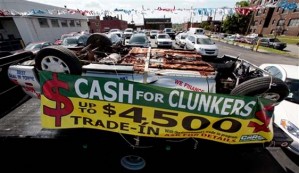
It's all over but the payback. While dealers wait for their money from the government, industry analysts try to figure what impact the CARS program will have on sales during the months to come.
By noon today, U.S. auto retailers will have to submit the final paperwork for their last Cash-for-Clunkers deals or forfeit the refunds they expect from the federal government.
The Cash Allowance Rebate System, or CARS, as it’s more formally known, has come to a close, barely one month and $3 billion after it began. As of midday Monday, dealers had already submitted claims covering 625,000 vehicles, which would generate at least $2.6 billion in voucher payments for dealers.
A sizable number of claims have yet to be submitted, however, and dealers were working frantically into the night trying to get the last paperwork completed, despite the decision to extend the deadline until midday Wednesday. In fact, that extension was largely due to the repeated crashes of the government’s own computer system, on Monday.
So far, barely a third of the money owed to dealers has been paid out, the Department Transportation, which oversees the program, has acknowledged, despite the hiring of hundreds of additional processors to handle the paperwork.
“It’s been a bureaucratic nightmare, it’s a complex program that should be a simple process,” Jeff Pohanka, who runs the 15-showroom Pohanka Group, in suburban Washington, D.C., told the PBS NewsHour.
One analyst has dubbed the Clunkers program a “miserable success.” Despite all the griping about the red tape, the delays and confusion, the fact is, U.S. car dealers haven’t seen so many customers in their showrooms in several years.
“We estimate that the light vehicle SAAR (the Seasonally Adjusted Annual sales Rate) will be in the 14.5 million range,” for August, forecast Deutsche Bank auto analyst Rod Lache. That would be a more than 8% increase compared to August 2008, and the first time the U.S. market will have reported a year-over-year sales gain since fuel prices started climbing early in ’08.
Domestic makers, according to preliminary data collected by Deutsche Bank, could see 30% sales gains. But, if Ford is an example, they could lose share. That’s because the Japanese, on the whole racked up more sales than Detroit’s Big Three who collectively accounted for only about 40% of the vehicles sold through the Clunkers program. Nonetheless, there will be few losers in August.
“This anomalous result is clearly related to the extremely popular CARS program,” the analyst added, but Lache cautioned that, “we expect a significant fall-off… once CARS ends.”
But how much is a matter of intense debate and will likely only be answered through experience in the coming weeks. The challenge is trying to figure out exactly who bought new vehicles under the CARS program. Analysts suggest these buyers fall into several different categories:
Those who would have bought vehicles, anyway, in July or August;
Those who would’ve bought vehicles earlier in the year but delayed their decision because of one problem or another – what can be described as “pent-up demand;”
Those who would have traded in on used cars only;
And those who would have traded in later this year or early in 2010.
The last group is the biggest worry. This so-called “pull forward” could cut into sales in the near-term, warns Lache, to the tune of as much as 50,000 sales a month. That, he adds, could depress the hoped-for market turnaround.
And it could force the industry to take unwanted steps to keep the momentum of the Clunkers program going, contends Dan Gorrell, automotive analyst with California-based Autostrategem.
“We’re going to have a let down,” as CARS wraps up, forecasts Gorrell. And “to keep the momentum up, there’s going to have to be an increase in incentives,” something automakers had been hoping to curb, rather than build back up.
Another factor could work to build up demand, however, says Gorrell. “What I’m watching for is some sign of consumer confidence (but) we certainly aren’t seeing that in retailing, yet.”
Despite such cautious projections, automakers are taking a moderately positive approach to their post-Clunkers world. General Motors, for example, will open up about 1300 assembly line slots as it expands production of the new, high-mileage Chevrolet Cruze. And as TheDetroitBureau.com reported last week, other makers, including Ford, Toyota and Mazda, are boosting production during the remainder of the current quarter and into the final three months of 2009 to help rebuild inventories depleted by the CARS program. Mazda, for example, has completely run out of its Mazda5 minivans.
Another question likely to be answered only by time is whether the Clunkers program has helped shift market demand, long-term, to more fuel-efficient vehicles. The voucher program ran out of cash more quickly than expected, in part, because buyers were opting for higher-mileage trade-ins than anticipated, so more of them qualified for the higher $4,500 vouchers.
But on the whole, revealed a recent study by Experian Automotive, there’s been only the most modest shift in the market, despite last year’s record fuel prices. After a brief surge in mid-2008, for example, hybrid-electric vehicles accounted for just 2% of the market, in June of this year, the same as they did in January ’08. And the same could be said for small and entry-level vehicles, according to Experian data.
Small cars and hybrids were the big winners under Clunkers, but if tradition holds, American buyers will go right back to old purchase patterns now that the program has wrapped up.
